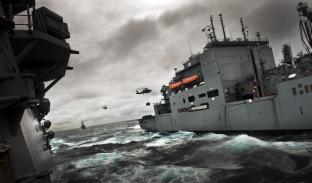
This highlight presents seven case studies, which illustrate both past and current challenges of naval warfare and maritime security. These cases allow lecturers, students and professionals to dig into some legal issues arising around the Second World War’s battles on the high seas, as well as various maritime questions related to contemporary conflicts, such as blockades and the distinction between civilian and military ships.
During the Second World War, the particularities of the conduct of hostilities at sea gave rise to many legal questions. In British Policy towards German Shipwrecked, for example, a British Legal advisor argued that the surrender of submarines should generally not be accepted and that the attack should be pressed home in spite of the flying of a white flag. In British Military Court at Hamburg, The Peleus Trial, a German Captain defended his order to destroy all floating wreckage to prevent Allied planes from using it to find and destroy his ship – even though he knew that would mean a number of the shipwrecked would have no chance of surviving.
Although this era of naval battles seems to be behind us, modern naval warfare also raise challenges. The so-called “fog of war” often is thicker at sea, thus making more difficult the identification of civilian and military ships, such as in Israel, Navy Sinks Dinghy off Lebanon. Measures that could amount to naval blockades, such as in Israel/Lebanon/Hezbollah Conflict in 2006 and in Yemen, Potential Existence and Effects of Naval Blockade, can have grave humanitarian consequences and raise many legal questions as well. Sri Lanka, Naval War Against Tamil Tigers shows that challenges related to asymmetric warfare, notably with regard to the principle of distinction and the prohibition of perfidy, also sometimes occur in war at sea.
One can, however, not simply divide naval warfare between World War II battles and current conflicts. The technological developments that occurred in-between were progressive. As can be seen in Argentina/United Kingdom, The Red Cross Box, the 1982 Falkland/Malvinas Islands conflict marked the use by the British – for the first time in the history of medical transports – of radio communications by satellite. This case highlights how technical developments may pose challenges to the law.
"A to Z" and “The Law” sections of the Online Casebook
The "A to Z" section of the Online Casebook helps to find information onspecific issues related to war at sea, such as Sea mines, Blockade, Naval bombardment, Merchant shipping, Shipwrecked or Hospital ship. Major features of IHL associated with Naval warfare can be found under “The Law”.
To go further…
On 4 May 2017, on the occasion of the online launch of the Updated Commentary on the Second Geneva Convention, the ICRC convened a panel of experts at the Humanitarium to discuss the Commentary's main findings. This conference can be watched online and features a keynote speech by Peter Maurer, President of the ICRC, which introduces this updated Commentary and highlights the issues at stake. A written version of the speech is published here.
The latest issue of the International Review of the Red Cross on "War and security at sea" is available. Among the many thought-provoking articles, Professor Wolff Heintschel von Heinegg discusses The difficulties of conflict classification at sea: Distinguishing incidents at sea from hostilities.
If you are looking for a contemporary restatement of international law applicable to armed conflicts at sea, the San Remo Manual on International Law Applicable to Armed Conflicts at Sea was prepared between 1988 and 1994 by a group of legal and naval experts participating in their personal capacities. It recalls that the key principles of the law of war on land are applicable to war at sea. For example, the principle of distinction and the requirement to take precautionary measures when launching an attack are clearly formulated. The concept of “military objective” was included and adapted to war at sea. Two decades later, in an article in the above mentioned issue of the Review, Professor Steven Haines reviews the law dealing with armed conflict at sea: War at sea: Nineteenth-century laws for twenty-first century wars?
Photo caption: The Arleigh Burke-class guided-missile destroyer USS Gridley pulls along side the Military Sealift Command dry cargo ship USNS Richard E. Byrd during a vertical replenishment at sea. Gridley is on a deployment with the Carl Vinson strike group to the U.S. 7th Fleet area of responsibility. Copyright: Navy Visual News Service. Photo by Petty Officer 3rd Class Travis Mendoza
